Index relies entirely on the support of donors and readers to do its work.
Help us keep amplifying censored voices today.
[vc_row][vc_column][vc_column_text]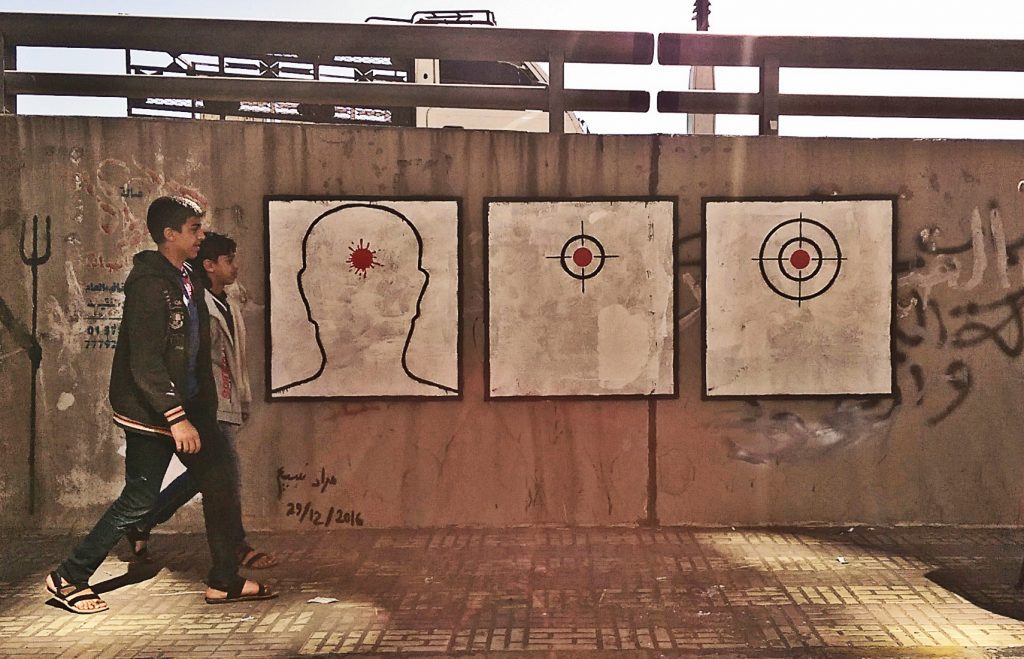
US president Donald Trump’s executive order banning citizens of seven predominantly Muslim countries from travelling to the USA for has had devastating consequences for thousands of people. Among them is Index on Censorship Award winner Murad Subay. The Yemeni street artist is now unable to visit his wife, who is currently studying in the USA.
“It’s really frustrating to even start thinking that I won’t be able to see her for that long,” he told Index. “She was supposed to visit during summer break, however, it seems that she can’t do that now.”
With uncertainty surrounding how the Trump administration’s policy towards Yemen will play out, the couple are now facing the very real prospect of not seeing each other until she finishes her studies four years from now.
“It’s been a really difficult time for both of us because it’s the first time we’ve been away from each other for more than a month,” Subay said. “I can’t say that this doesn’t have its negative effects on my work, for it surely does.”
At home, the worries that have plagued Subay throughout the Obama administration remain, particularly Trump’s continuation – and possible escalation – of his predecessor’s drone strikes in Yemen, which by February 2016 had killed up to 729 Yemenis including 100 civilians. One rural counter-terrorism raid authorised by Trump has already left at least 10 women and children dead, according to Al-Jazeera.
2016 Freedom of Expression Fellow Murad SubayMurad Subay is the 2016 Index on Censorship Freedom of Expression Arts Award-winner and fellow. His practice involves Yemenis in creating murals that protest the country’s civil war. Read more about Subay’s work. |
“Trump has no right to make things even worse for Yemenis. Yemen is already suffering from US arms deals with Saudi Arabia that helped fuel this war. Barring Yemenis from entering the USA under his administration only adds to these troubles.”
The war has been hitting close to home for Subay in recent months. Two of his cousins were recruited by warring parties and killed on the battlefield. – Fuad Subay, aged 26, was a soldier killed in Albuka’a, and Yaser Subay, just 14, was recruited by Houthis and killed in Isilan.
On top of this, a close friend of his, the respected investigative journalist Mohammed Alabsi, was killed in an apparent assassination. According to the Yemen Times, Alabsi had gone out for dinner in Sana’a with a cousin on 20 December. A little while later both men were rushed to hospital, where Alabsi died.
“I was told that blood came out of his ears and eyes,” Subay said. “Mohammed was investigating the black markets trading in oil that were associated with high-ranking politicians. I do not know the exact details of this, but what I do know is that Yemen has lost one of its most important and noblest investigative journalists, and that I lost a dear friend.”
An investigation into Alabsi’s death is underway.
Subay addressed a recent wave of violence against civilians, including journalists and public figures, in a mural entitled Assassination’s Eye, painted on the Mathbah Bridge in Sana’a in late December. Part of the Ruins Campaign, the minimalist painting depicts a sniper’s crosshairs training in on a human target.
“It conveys the assassin’s point of view, where it first feels like it is only a part of training on how to hit a target, but then in the final square the bullet ends up in the head of a real person rather than a target board,” Subay explained. “These assassinations have spread vastly since 2012, where they were mostly carried out among the military ranks and politicians. Lately, however, these operations have been targeting civilians too. I was planning to address this issue some time ago after hearing about the assassinations of innocent civilians in different places of the country, and that was just two weeks before I was shocked by the death of my friend.”
Elsewhere, Subay has been asked to serve as a judge for the Italian arts award, Fax for Peace, which invites students and artists from around the world to send pictures, videos or animations on the themes of peace, tolerance, human rights and the fight against all forms of racism. He said of the role: “It is a great pleasure to be selected as a judge in this contest and it is a big responsibility, which I hope to be able to carry out effectively.”
However, with Yemen’s economic circumstances ever worsening, and many working people now into their fourth month without receiving salaries, he sees difficult times ahead.
“It’s very harsh to see people every day looking for anything to eat from garbage, waiting along with children in rows to get water from the public containers in the streets, or the ever increasing number of beggars in the streets. They are exhausted, as if it’s not enough that they had to go through all of the ugliness brought upon them by the war.”
Referring to the deaths of his cousins and his close friend, he added: “No one can live in this country and not be affected by the war. This all happened in the last three or four months. These events make a month in Yemen feel like a year.”[/vc_column_text][vc_basic_grid post_type=”post” max_items=”4″ element_width=”6″ grid_id=”vc_gid:1486138786513-e5ca059b-efd0-1″ taxonomies=”8196″][/vc_column][/vc_row]
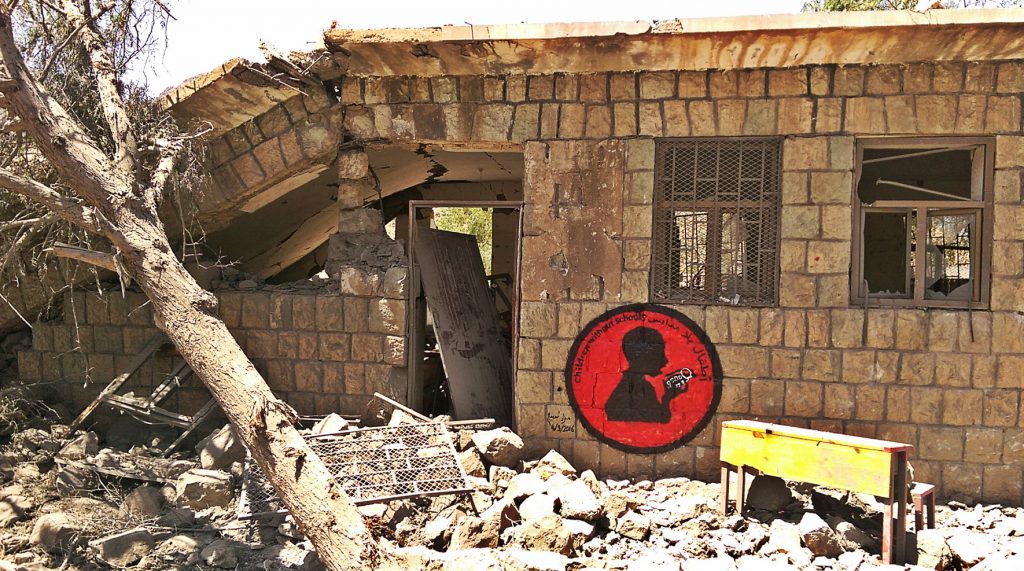
Credit: Ruins campaign. Bani Waleed, September 2016
On 3 September 2016, a group of Houthi rebels convened a meeting at al-Najah School in the al-Haima district of Bani Waleed, a local witness told Murad Subay, street artist and winner of the 2016 Index on Censorship award for arts, that the men entered the school without permission.
“We are not with any of the warring parties – we are caught in the middle,” the witness said.
Soon after, the school was destroyed in an airstrike carried out by the Saudi Arabian-led military coalition, killing one disabled student and adding 1,200 to the more than 3.4 million already forced out of education in the country as over 3,600 schools have been forced to close in the course of the war.
“Can you imagine? These are the soldiers of the wars to come,” Subay told Index. “Without education, these children could become tomorrow’s fighters and tools in the hands of extremists.”
At dawn on 4 September Subay travelled to Bani Waleed to create a mural on what remained of al-Najah.
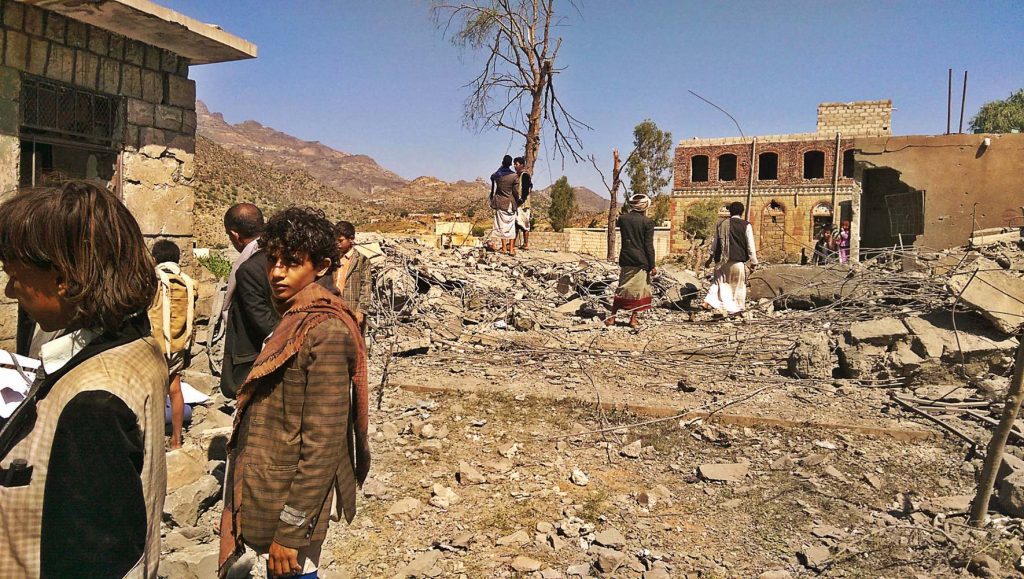
Credit: Ruins campaign. Bani Waleed, September 2016
“When we got there I asked some of the students what they were going to do now that their school was destroyed and some told me they will go to Sanaa while others said they will travel to surrounding villages,” Subay said. “But it will be much more difficult for the 400 girls who attended the school because traditions in Yemen mean they will not be able to travel alone, making it impossible for them to go to other villages to study.”
2016 Freedom of Expression Fellow Murad SubayMurad Subay is the 2016 Index on Censorship Freedom of Expression Arts Award-winner and fellow. His practice involves Yemenis in creating murals that protest the country’s civil war. Read more about Subay’s work. |
Destroying schools isn’t a big deal for the warring parties, the artist added. “Some of the children of those leaders who shout ‘death to America’ are studying at the best universities in the world, including in the USA, while each bombed school in Yemen – especially big ones like al-Haima – will take years to rebuild.”
The situation is made even more difficult in a time of war when resources and building materials are almost impossible to come by. “Even if the West stopped supplying weapons to Saudi Arabia today and patted themselves on the back saying ‘we are doing good’, Saudi Arabia already has enough to wage wars for another 150 years if it wants.”
If there is any hope for peace to prevail and schools, hospitals and other buildings belonging to the people are to be rebuilt, countries like Britain and America should take a step further and tell Saudi Arabia “to show restraint”, Subay said.
“While Saudi Arabia is doing the majority of the destruction, all sides of the war in Yemen must take responsibility.”
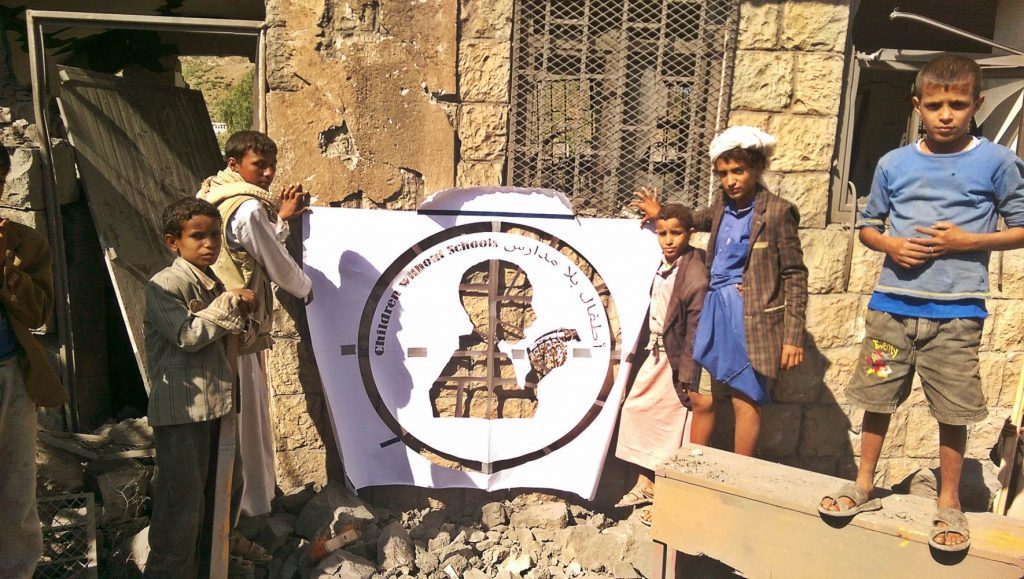
Credit: Ruins campaign. Bani Waleed, September 2016
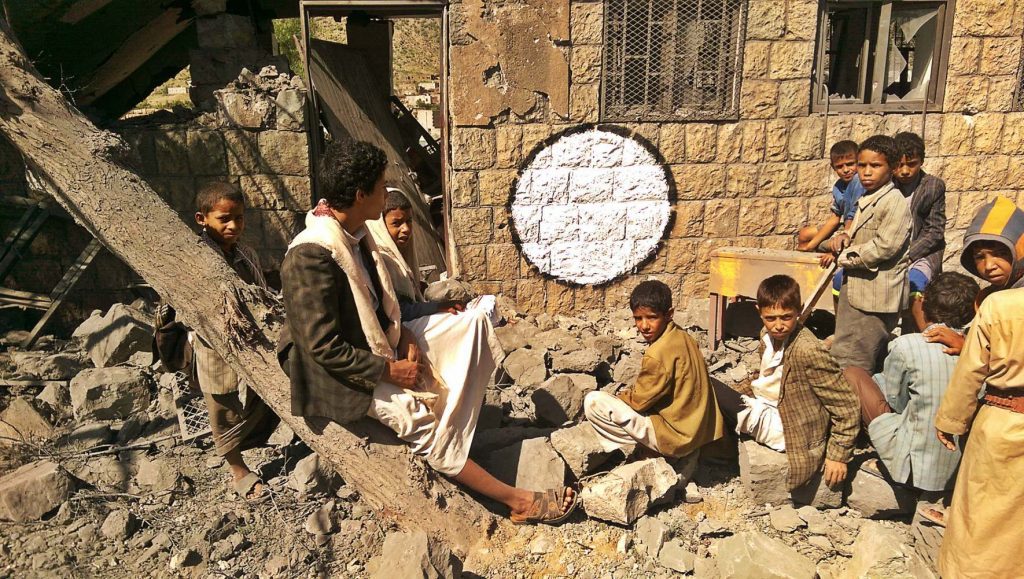
Credit: Ruins campaign. Bani Waleed, September 2016
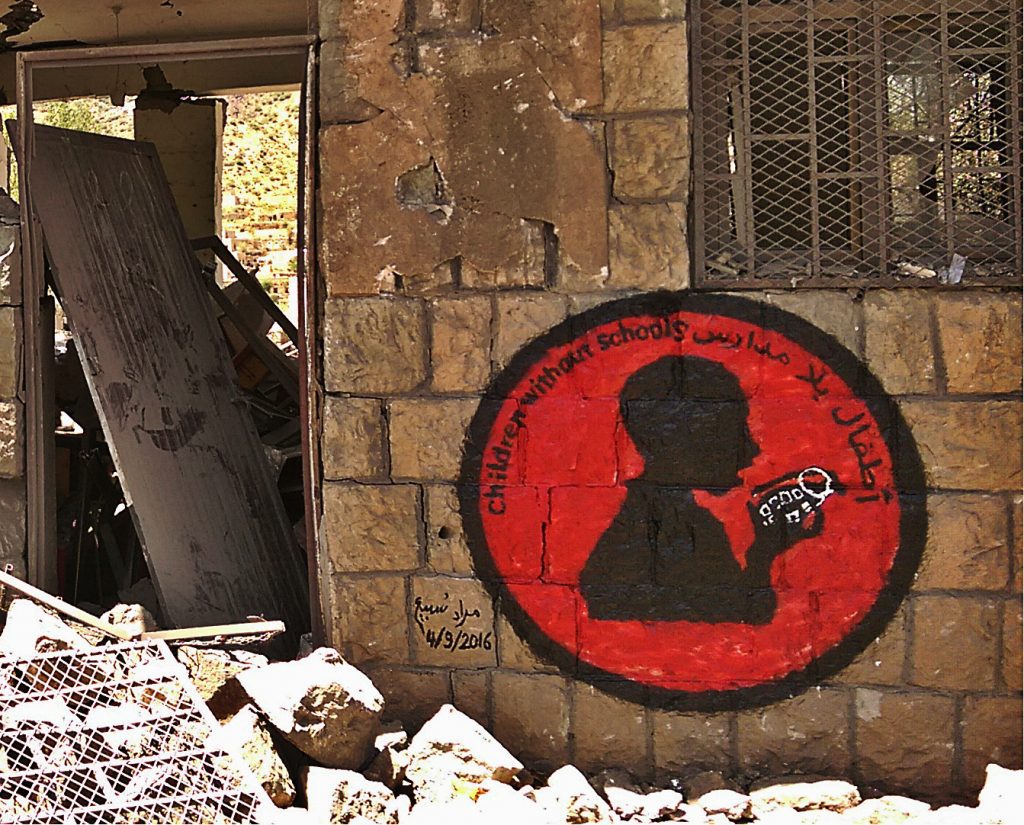
Credit: Ruins campaign. Bani Waleed, September 2016
The mural completed on 4 September depicts a child holding a hand grenade in place of a book, with the words “Children without schools” painted in English and Arabic.
When painting with fellow artists from the Ruins campaign – set up in May 2015 in collaboration with fellow artist Thi Yazen to paint on the walls of buildings damaged by the war – on 25 August, the group were arrested and interrogated by a local militia.
“They asked us to sign a letter with our fingerprints promising that we would not return again without permission,” Subay explains. “I actually did have permission from a local tribal leader but they wouldn’t listen.”
The artists were told if they returned they would be punished.
“My friends were very afraid and some of them said even with permission they would not return,” Subay said. “It was a strange situation for them.”
Subway himself isn’t put off and is already looking forward the next Ruins campaign, wherever that may be.
(2/2)whoever defaced the murals, wrote the word “steadfast” on both of them. #Yemen #Ruins_Campaign pic.twitter.com/3mhCfEulJT
— murad subay (@muradsubay) June 15, 2016
The last time he spoke with Index, Ruins had just completed a series of murals in front of the Central Bank of Yemen to represent the country’s economic collapse. Soon after the murals were finished, Houthi rebels defaced two out of the three works of art, writing “Samidoon” (صامدون), meaning “steadfast”, which is one of their slogans.
Assessing the situation in Yemen and the many different sides of the conflict, Subay said: “It is very difficult. Every night we hear airstrikes here and there, but we go on with our lives.”
“But any day when I can paint is a good one.”
Nominations are now open for 2017 Index on Censorship Freedom of Expression Awards and will remain open until 11 October. You can make yours here.
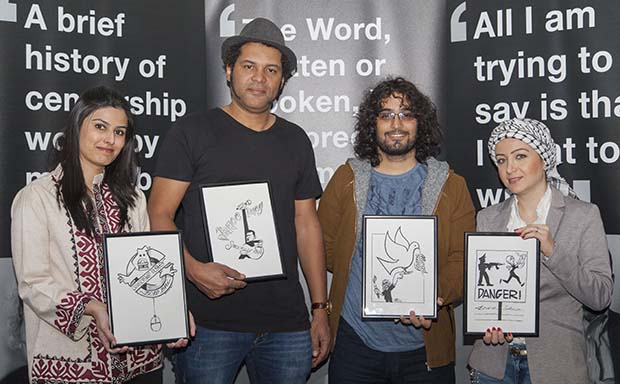
Winners of the 2016 Freedom of Expression Awards: from left, Farieha Aziz of Bolo Bhi (campaigning), Serge Bambara — aka “Smockey” (Music in Exile), Murad Subay (arts), Zaina Erhaim (journalism). GreatFire (digital activism), not pictured, is an anonymous collective. Photo: Sean Gallagher for Index on Censorship
[vc_row][vc_column][vc_column_text]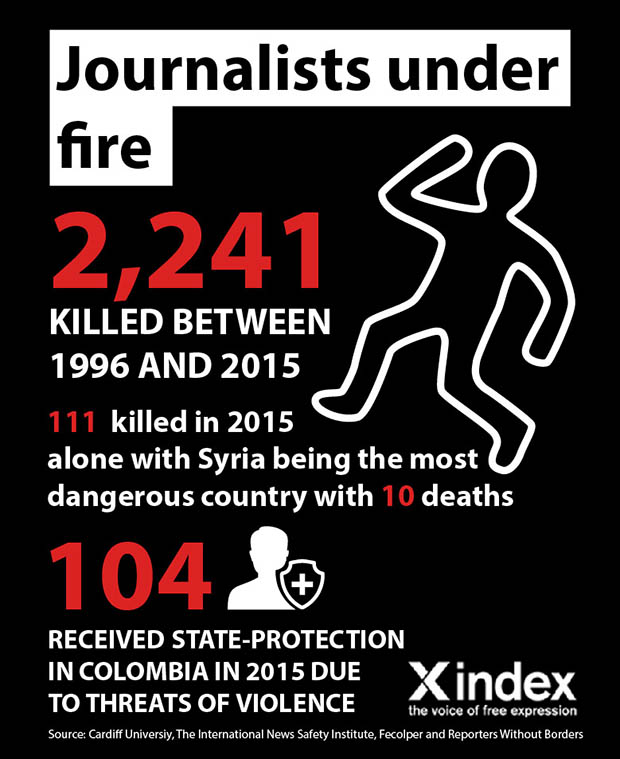
The truth is in danger. Working with reporters and writers around the world, Index continually hears first-hand stories of the pressures of reporting, and of how journalists are too afraid to write or broadcast because of what might happen next.
In 2016 journalists are high-profile targets. They are no longer the gatekeepers to media coverage and the consequences have been terrible. Their security has been stripped away. Factions such as the Taliban and IS have found their own ways to push out their news, creating and publishing their own “stories” on blogs, YouTube and other social media. They no longer have to speak to journalists to tell their stories to a wider public. This has weakened journalists’ “value”, and the need to protect them. In this our 250th issue, we remember the threats writers faced when our magazine was set up in 1972 and hear from our reporters around the world who have some incredible and frightened stories to tell about pressures on them today.
Around 2,241 journalists were killed between 1996 and 2015, according to statistics compiled by Cardiff University and the International News Safety Institute. And in Colombia during 2015 104 journalists were receiving state protection, after being threatened.
In Yemen, considered by the Committee to Protect Journalists to be one of the deadliest countries to report from, only the extremely brave dare to report. And that number is dwindling fast. Our contacts tell us that the pressure on local journalists not to do their job is incredible. Journalists are kidnapped and released at will. Reporters for independent media are monitored. Printed publications have closed down. And most recently 10 journalists were arrested by Houthi militias. In that environment what price the news? The price that many journalists pay is their lives or their freedom. And not just in Yemen.
Syria, Mexico, Colombia, Afghanistan and Iraq, all appear in the top 10 of league tables for danger to journalists. In just the last few weeks National Public Radio’s photojournalist David Gilkey and colleague Zabihullah Tamanna were killed in Afghanistan as they went about their work in collecting information, and researching stories to tell the public what is happening in that war-blasted nation. One of our writers for this issue was a foreign correspondent in Afghanistan in 1990s and remembers how different it was then. Reporters could walk down the street and meet with the Taliban without fearing for their lives. Those days have gone. Christina Lamb, from London’s Sunday Times, tells Index, that it can even be difficult to be seen in a public place now. She was recently asked to move on from a coffee shop because the owners were worried she was drawing attention to the premises just by being there.
Physical violence is not the only way the news is being suppressed. In Eritrea, journalists are being silenced by pressure from one of the most secretive governments in the world. Those that work for state media do so with the knowledge that if they take a step wrong, and write a story that the government doesn’t like, they could be arrested or tortured.
In many countries around the world, journalists have lost their status as observers and now come under direct attack. In the not-too-distant past journalists would be on frontlines, able to report on what was happening, without being directly targeted.
So despite what others have described as “the blizzard of news media” in the world, it is becoming frighteningly difficult to find out what is happening in places where those in power would rather you didn’t know. Governments and armed groups are becoming more sophisticated at manipulating public attitudes, using all the modern conveniences of a connected world. Governments not only try to control journalists, but sometimes do everything to discredit them.
As George Orwell said: “In times of universal deceit, telling the truth is a revolutionary act.” Telling the truth is now being viewed by the powerful as a form of protest and rebellion against their strength.
We are living in a historical moment where leaders and their followers see the freedom to report as something that should be smothered, and asphyxiated, held down until it dies.
What we have seen in Syria is a deliberate stifling of news, making conditions impossibly dangerous for international media to cover, making local news media fear for their lives if they cover stories that make some powerful people uncomfortable. The bravest of the brave carry on against all the odds. But the forces against them are ruthless.
As Simon Cottle, Richard Sambrook and Nick Mosdell write in their upcoming book, Reporting Dangerously: Journalist Killings, Intimidation and Security: “The killing of journalists is clearly not only to shock but also to intimidate. As such it has become an effective way for groups and even governments to reduce scrutiny and accountability, and establish the space to pursue non-democratic means.”
In Turkey we are seeing the systematic crushing of the press by a government which appears to hate anyone who says anything it disagrees with, or reports on issues that it would rather were ignored. Journalists are under pressure, and so is the truth.
As our Turkey contributing editor Kaya Genç reports on page 64, many of Turkey’s most respected news outlets are closing down or being forced out of business. Secrets are no longer being aired and criticism is out of fashion. But mobs attacking newspaper buildings is not. Genç also believes that society is shifting and the public is being persuaded that they must pick sides, and that somehow media that publish stories they disagree with should not have a future.
That is not a future we would wish upon the world.
Order your full-colour print copy of our journalism in danger magazine special here, or take out a digital subscription from anywhere in the world via Exact Editions (just £18* for the year). Each magazine sale helps Index on Censorship fight for free expression worldwide.
*Will be charged at local exchange rate outside the UK.
Magazines are also on sale in bookshops, including at the BFI and MagCulture in London, Home in Manchester, Carlton Books in Glasgow and News from Nowhere in Liverpool as well as on Amazon and iTunes. MagCulture will ship anywhere in the world.
[/vc_column_text][/vc_column][/vc_row][vc_row][vc_column][vc_custom_heading text=”From the Archives”][vc_row_inner][vc_column_inner width=”1/3″][vc_single_image image=”94291″ img_size=”213×289″ alignment=”center” onclick=”custom_link” link=”http://journals.sagepub.com/doi/pdf/10.1080/03064228208533353″][vc_custom_heading text=”Afghanistan in 1978-81″ font_container=”tag:p|font_size:24|text_align:left” link=”url:http%3A%2F%2Fjournals.sagepub.com%2Fdoi%2Fpdf%2F10.1080%2F03064228208533353|||”][vc_column_text]April 1982
Anthony Hyman looks at the changing fortunes of Afghan intellectuals over the past four or five years.[/vc_column_text][/vc_column_inner][vc_column_inner width=”1/3″][vc_single_image image=”94251″ img_size=”213×289″ alignment=”center” onclick=”custom_link” link=”http://journals.sagepub.com/doi/pdf/10.1080/03064228208533410″][vc_custom_heading text=”Colombia: a new beginning?” font_container=”tag:p|font_size:24|text_align:left” link=”url:http%3A%2F%2Fjournals.sagepub.com%2Fdoi%2Fpdf%2F10.1080%2F03064228208533410|||”][vc_column_text]August 1982
Gabriel García Márquez and others who faced brutal government repression following the 1982 election.[/vc_column_text][/vc_column_inner][vc_column_inner width=”1/3″][vc_single_image image=”93979″ img_size=”213×289″ alignment=”center” onclick=”custom_link” link=”http://journals.sagepub.com/doi/pdf/10.1080/03064228408533703″][vc_custom_heading text=”Repression in Iraq and Syria” font_container=”tag:p|font_size:24|text_align:left” link=”url:http%3A%2F%2Fjournals.sagepub.com%2Fdoi%2Fpdf%2F10.1080%2F03064228408533703|||”][vc_column_text]April 1983
An anonymous report from Amnesty point to torture, special courts and hundreds of executions in Iraq and Syria. [/vc_column_text][/vc_column_inner][/vc_row_inner][vc_separator][/vc_column][/vc_row][vc_row][vc_column width=”1/3″][vc_custom_heading text=”Danger in truth: truth in danger” font_container=”tag:p|font_size:24|text_align:left” link=”url:https%3A%2F%2Fwww.indexoncensorship.org%2F2016%2F05%2Fdanger-in-truth-truth-in-danger%2F|||”][vc_column_text]The summer 2016 issue of Index on Censorship magazine looks at why journalists around the world face increasing threats.
In the issue: articles by journalists Lindsey Hilsum and Jean-Paul Marthoz plus Stephen Grey. Special report on dangerous journalism, China’s most famous political cartoonist and the late Henning Mankell on colonialism in Africa.[/vc_column_text][/vc_column][vc_column width=”1/3″][vc_single_image image=”76282″ img_size=”medium” alignment=”center” onclick=”custom_link” link=”https://www.indexoncensorship.org/2016/05/danger-in-truth-truth-in-danger/”][/vc_column][vc_column width=”1/3″][vc_custom_heading text=”Subscribe” font_container=”tag:p|font_size:24|text_align:left” link=”url:https%3A%2F%2Fwww.indexoncensorship.org%2Fsubscribe%2F|||”][vc_column_text]In print, online. In your mailbox, on your iPad.
Subscription options from £18 or just £1.49 in the App Store for a digital issue.
Every subscriber helps support Index on Censorship’s projects around the world.
![]() SUBSCRIBE NOW[/vc_column_text][/vc_column][/vc_row]
SUBSCRIBE NOW[/vc_column_text][/vc_column][/vc_row]
Words by Alessio Perrone and Sean Gallagher
Photos: Sean Gallagher
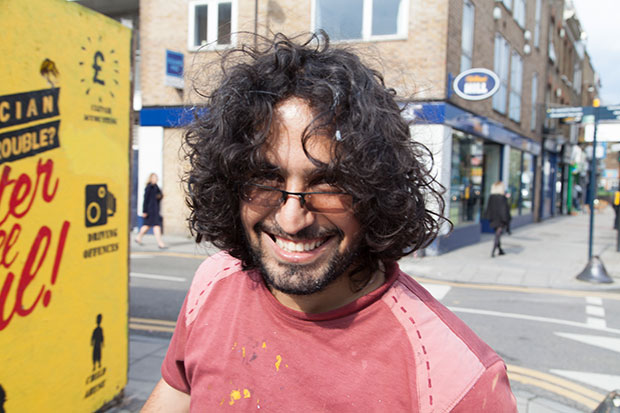
“I invite people like this: I just say – you paint now.” That’s how it works with street artist Murad Subay.
His murals grew from the frustration he felt as his homeland, Yemen, descended into chaos and factionalism. Amid the destruction and anger, Subay picked up his brush. With friends, he went out into the streets and began painting in broad daylight. Days passed, then people from the community joined him. All of them driven by their desire for peace amid Yemen’s civil war.
Since 2011 he’s created campaigns to encourage Yemenis to express their outrage at what their country has become. He and his collaborators have coloured walls, named the disappeared and marked ruins.
He always works during the day. It’s always part performance, part collaboration. Thursday 14 April was no different. Only the location had changed.
For his first mural outside Yemen, Subay took his brushes and paint to the corner of Hackney Road and Cremer Street to send a pointed message about the international community’s lack of humanity, especially toward his homeland. Even dogs are better than some of the global institutions and structures.
In London, to receive the 2016 Freedom of Expression Arts Award for his work, which Subay stressed is for Yemen. His acceptance speech was dedicated to the “unknown people who struggle to survive”.
Invited by Jay, the community curator of Art Under the Hood, Subay set up his equipment — with the help of new friends — and began transforming a hoarding into his vision using stencils he had laboured over since arriving on Saturday.
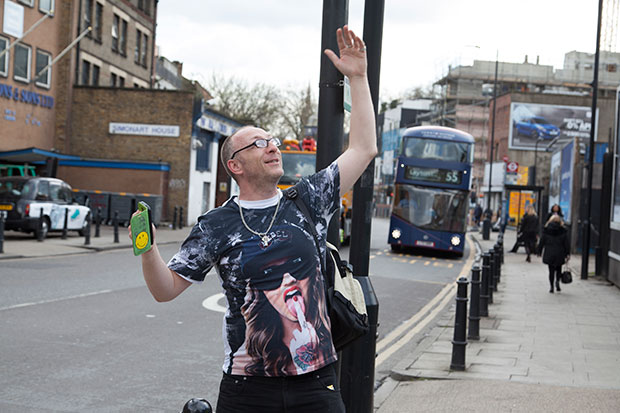
“I’m doing a sun dance.”
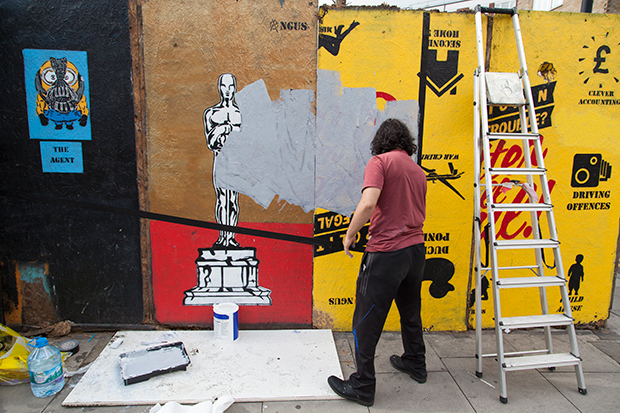
“I’m not the type of artist who zones out and thinks this is precious. It’s an ordinary thing for me”
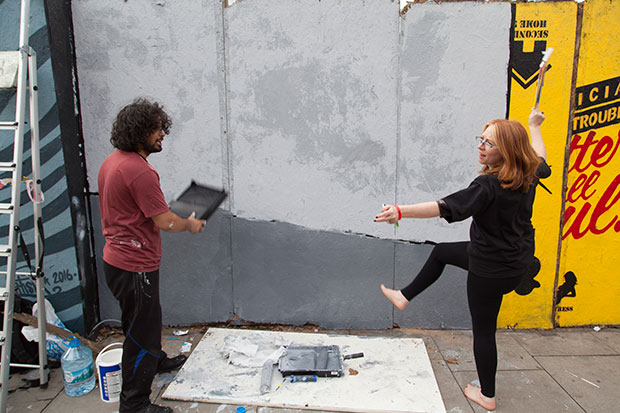
“How long will it take for it to dry?”
“In Sana’a, three minutes!” Then a few seconds later “Here, I don’t know”
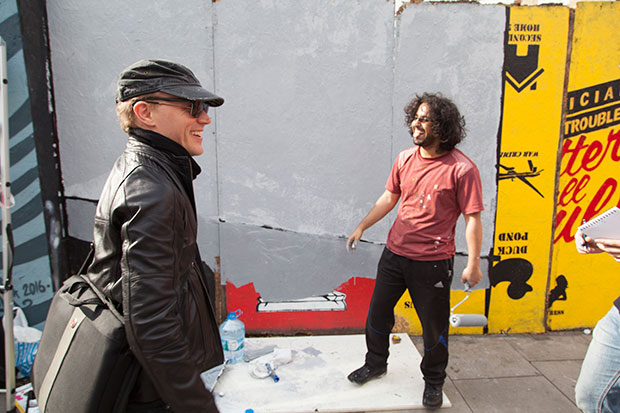
“Do you want me to do anything”
“Yes of course. Come here”
“Welcome to the holy state of Hackney, my friend. This is not a borough, not a city, it’s a state.”
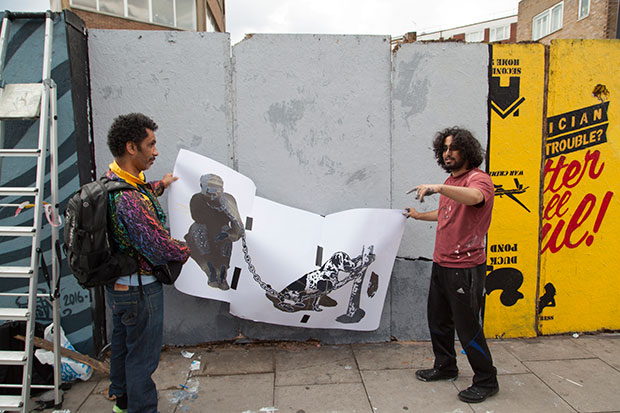
“I’ve worked on these stencils from time to time for four days. It’s hard to say how long it takes. Sometimes it takes three, four hours, other times five … Depends on what I do”
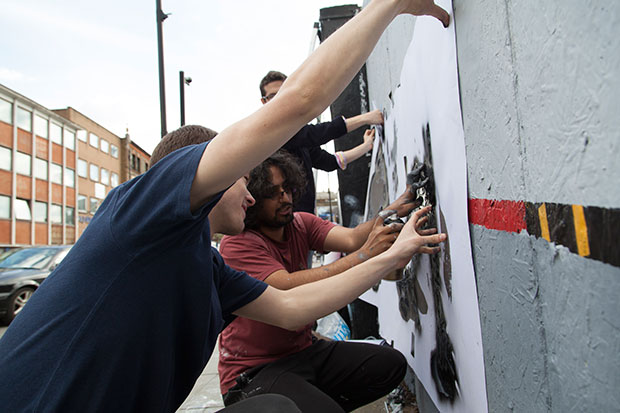
“First, try it on the cardboard to see how strong or light it is. Then press in the shape, light, not strong. Keep it at an angle close to the margins, so you can make sure you don’t spray outside the shape. Then perpendicular in the middle. Keep it light, light!”
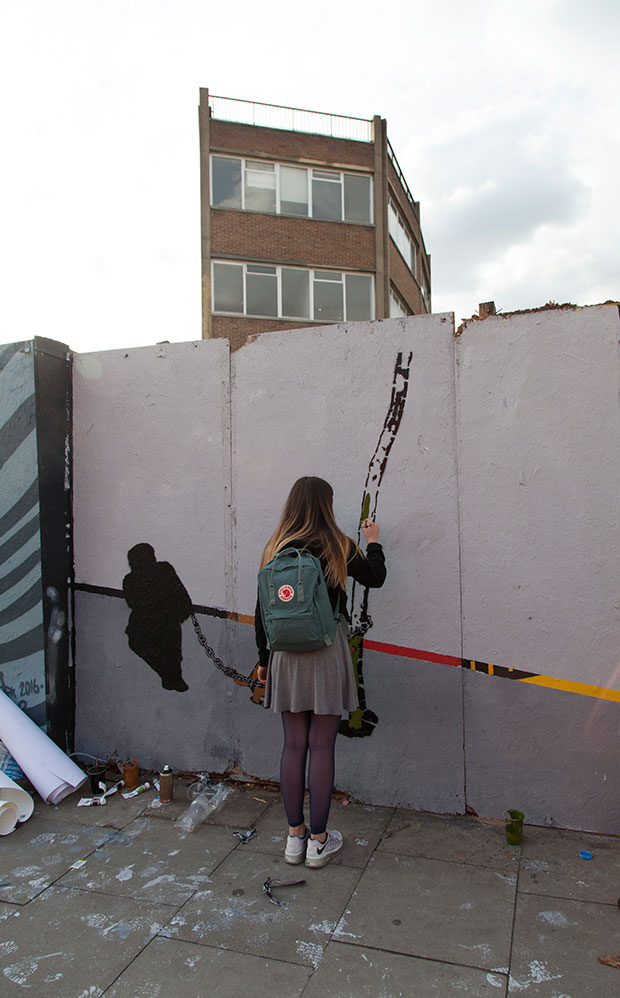
“Can I have a go?” a young woman asks.
“Yes of course!”
She stops for a moment, hesitant. Then she ends up staying until the very end. And in the end, Subay gives her, Éléa, the stencils when he finishes the mural.
“Do you paint?”
“A bit”
“Not a bit, you have to paint a lot! Painting is beautiful.”
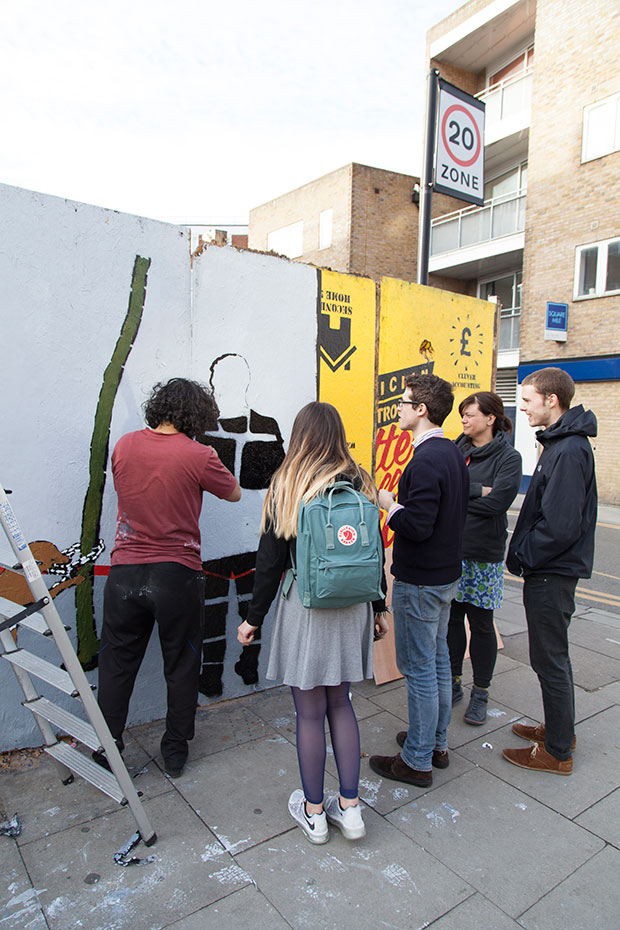
“They have artists in Yemen? First time I hear that!”
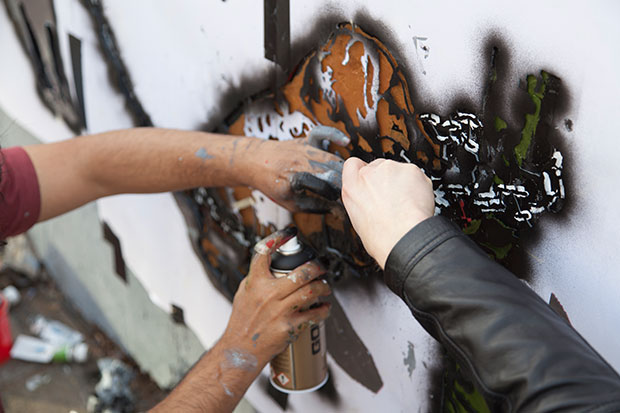
“You know how to spray right? Come and learn a bit!”
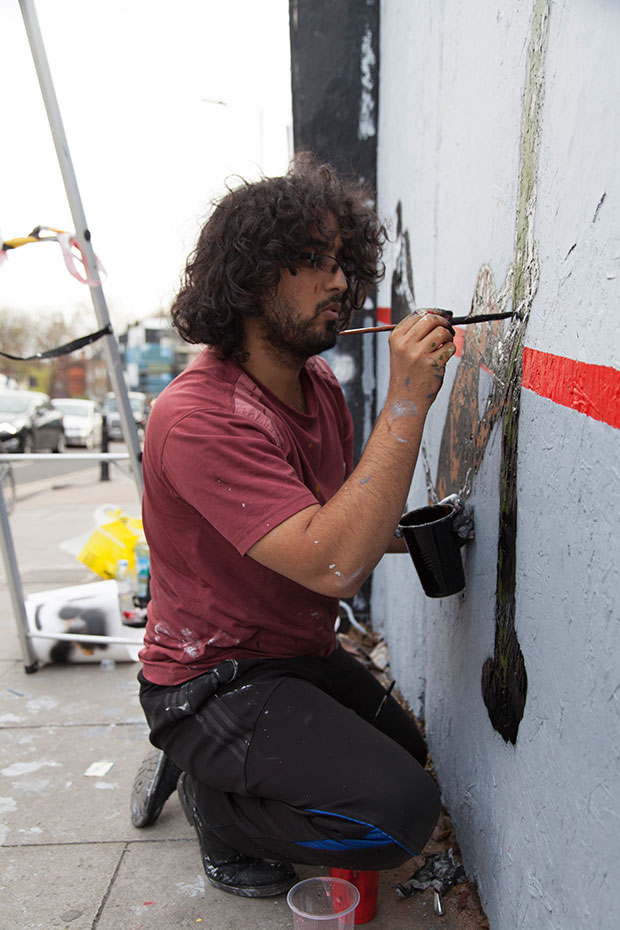
“When I started out, I was alone, and I did it all in one week. I am slow. In the beginning, I never thought people could join. But then they did. They say: ‘Oh look, the artist!’ And they join”
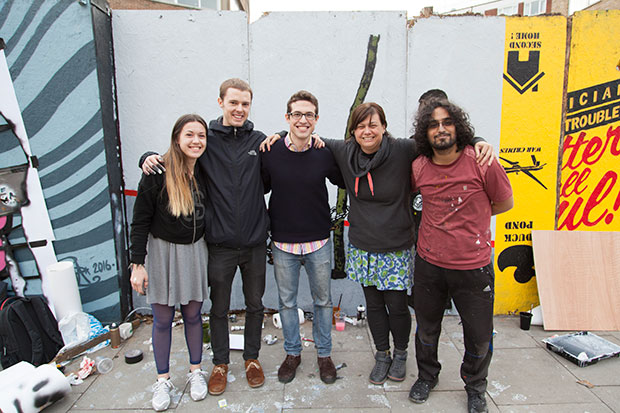
“These stencils, I made in Yemen. I staged a photo, printed it, then cut it out. That chained man is one of my relatives. He’s a very nice person. He jokes a lot and loves painting. I really like him. We work together a lot, on street art of course but also many different things.”
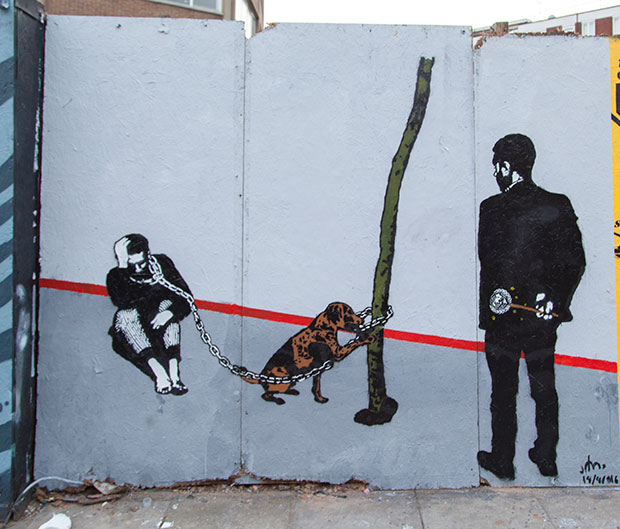
“It’s all about how the man is suffering. He’s not just Yemen or anybody in particular. It could be any man. The dog is trying to help, and is showing more kindness then the other man. The dog shows that it’s possible to help out, but the other man doesn’t want to do anything.”